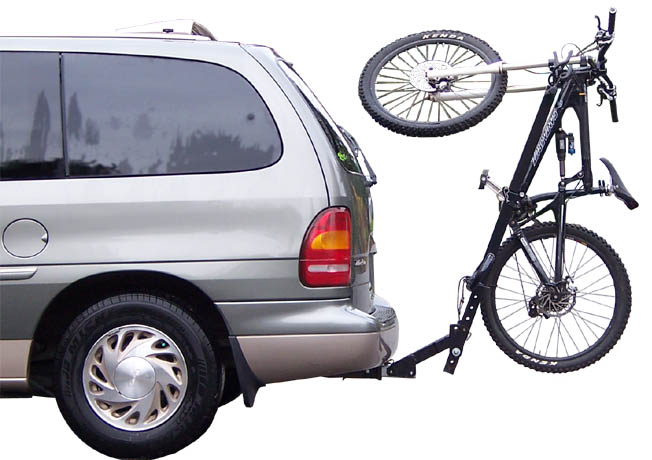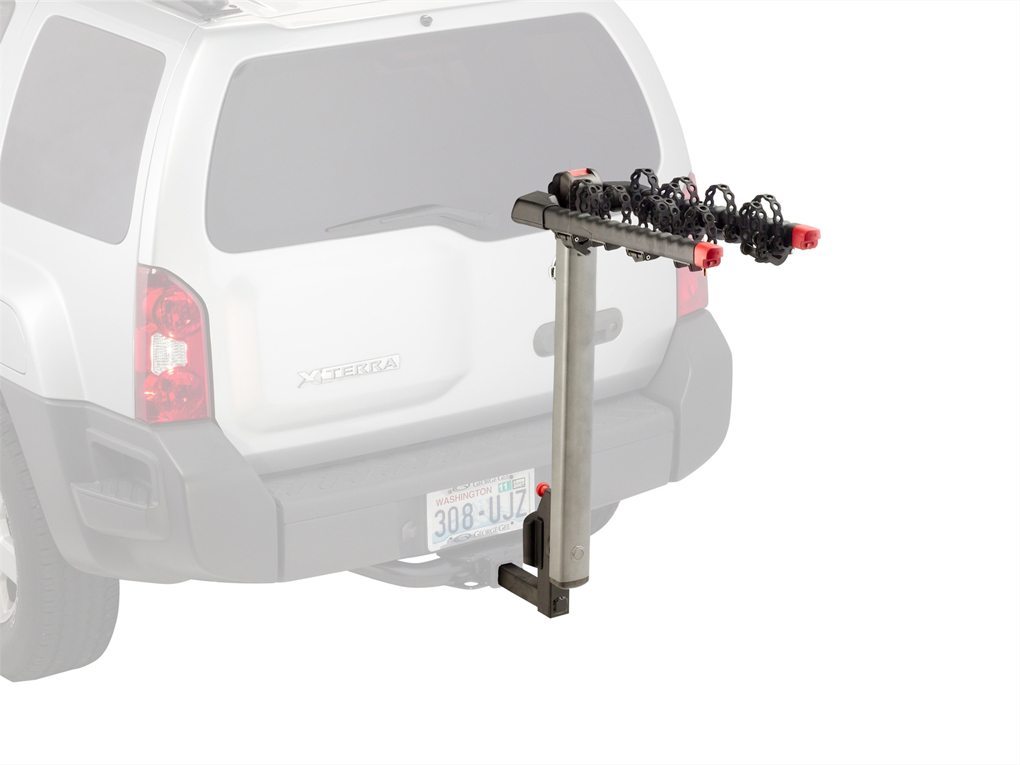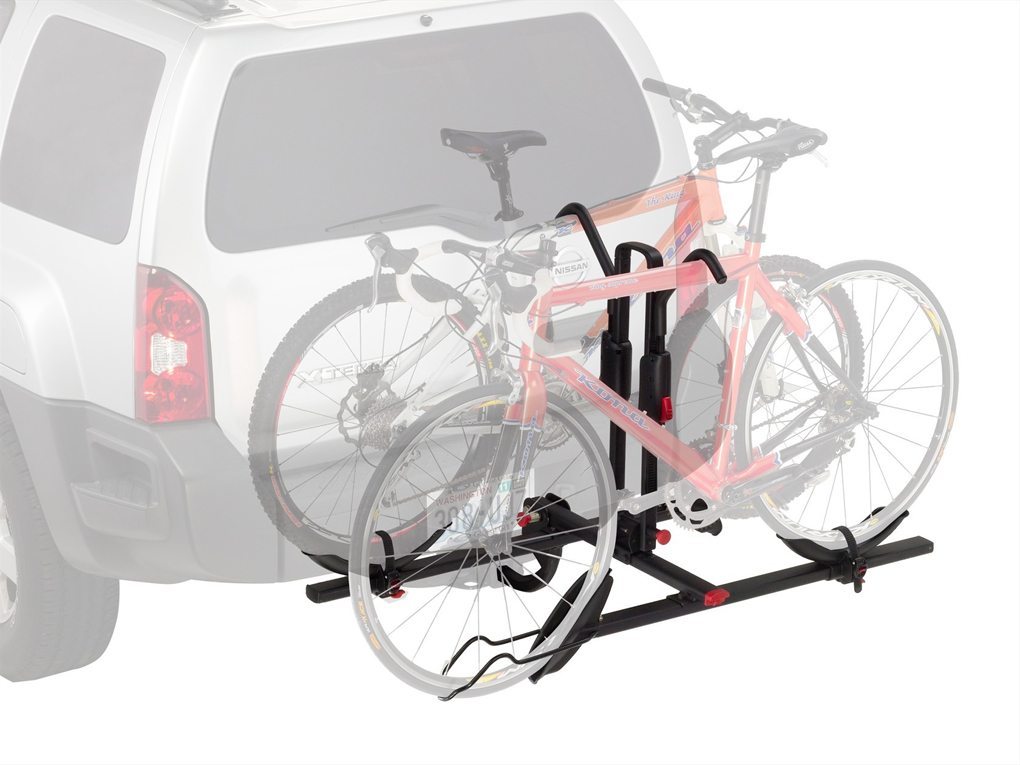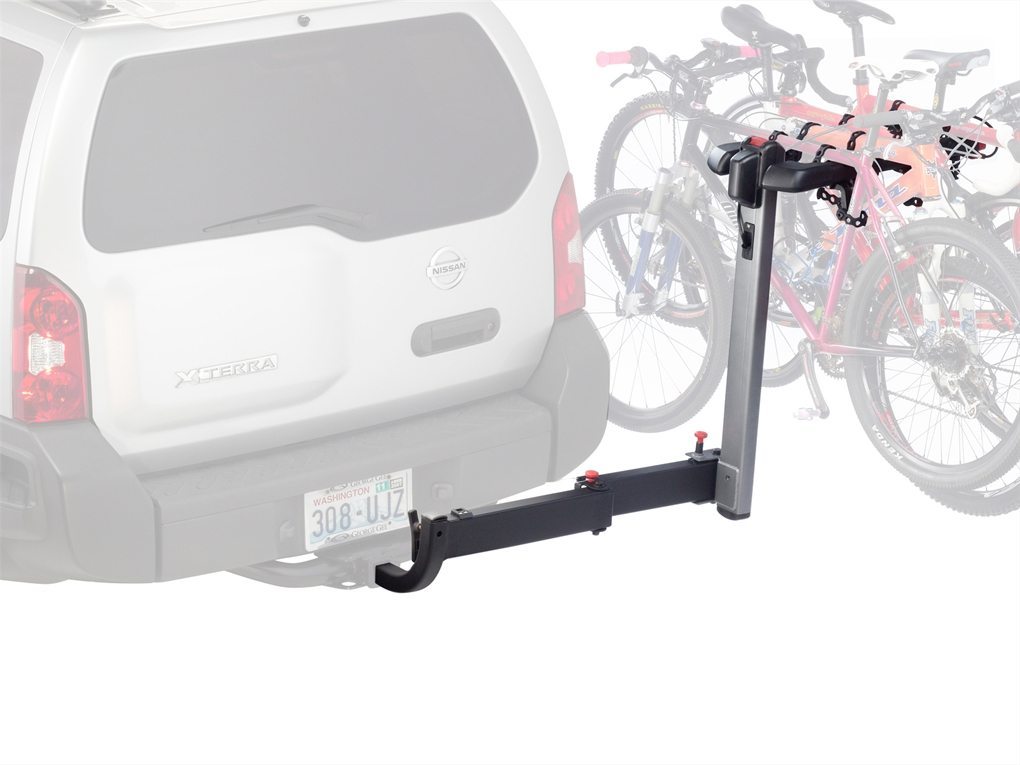Hitch Racks
Hitch racks tend to be a bit cheaper than a full roof rack system (roughly $175-500), and they’re usually quick and easy to install, which is certainly a bonus. On the downside, they’re not particularly versatile—I don’t know of any hitch racks that will carry both bikes and other gear, so your skis, kayak, and dog will have to be mounted elsewhere.
The primary downside of any hitch rack is the (hopefully) obvious fact that your vehicle needs a receiver hitch. If your vehicle doesn’t already have a hitch, you can add one, but that adds significantly to the cost. There are, of course, other benefits of having a hitch mount on your vehicle, but those benefits may not be particularly compelling if you don’t plan on towing anything.
The two most common types of hitch racks are those with a pair of parallel bars from which the bike hangs, and those with wheel trays that, by some means or another, grasp the bike’s wheels (similar to the “wheels on” roof racks). There are some newer varieties of hitch racks that are gaining popularity, including a “wheels on” style rack that essentially hangs the bikes vertically by their forks. Some of these newer options solve some of the inherent issues with other hitch racks (such as bikes banging against each other in transit), but that sometimes comes at the cost of compatibility with varied frame types.
“Hanging fork” style racks are relatively new to the market, but they offer a lot of advantages and are rapidly gaining market share. They allow very easy bike mounting and they allow you to carry up to six bikes close to the back of the car. This greatly reduces the force on your trailer hitch while also increasing the rack’s ground clearance. Typically, the strapping system also provides a very sturdy bike tie down, which leads to minimal bike movement or interference between neighboring bikes. The downside is that they’re not particularly cheap, and they don’t work with every bike out there—mountain bikes work best, but road bikes and kids’ bikes may be problematic. The design of the rack also interferes with the access to the rear of many vehicles.

Parallel bars hitch racks tend to be cheaper, but suffers a few drawbacks. First, odd frame designs and small kids’ bikes can be difficult to mount. Second, you have to take off all the bikes if you want access to the one closest to the car. Third, because the rack itself is “tall,” it will almost always be in the way of accessing the back of the vehicle (whereas the “wheel tray” variety is usually out of the way unless there are bike mounted on it).

Wheel tray-style hitch racks tend to be a bit more expensive, but are the easiest to use of any rack system I’ve spent time with. They have essentially the same benefits and drawbacks of the “wheels on” roof racks, but with the added bonus of being close to the ground.

The big upside of hitch mounts is the ease of use. Regardless of the style of hitch rack, the bikes are close to the ground, so loading / unloading them is as easy on a hitch rack as any system out there.
Because hitch racks often space the bikes together fairly closely, however, I’ve found that there are often issues with bike-on-bike contact. A brake lever dragging on an adjacent top tube will ruin your otherwise pristine paint job pretty quickly, so it can be a headache arranging bikes on a hitch rack to make sure everything is safe and secured. (This same issue theoretically applies to roof racks, but on roof racks, the spacing isn’t set by the manufacturer, so you can mount the racks a little farther apart if need be.)
The most common issue with hitch racks is that they severely limit access to the back of the vehicle. While some higher-end hitch racks swing out of the way, many hitch racks are going to make opening the back of your SUV a bit tricky.

Another unrelated but potentially problematic issue comes with putting a “wheel tray” style hitch rack (especially a longer four-bike version) on a vehicle that doesn‘t have a lot of ground clearance. Especially on rolling dirt roads, there’s a good chance that at some point you’ll ground-out the rack. Most of the time this isn’t a huge problem, but it certainly doesn’t do any favors for the rack.
Another noteworthy issue is that hitch racks can be a bit more difficult to lock. Most lockable racks incorporate a cable that runs through the bikes. While this will keep honest people honest, dishonest people that happen to own bolt cutters aren’t going to be particularly concerned with a 10mm cable.
NEXT: STRAP-ON RACKS

Great overview of rack systems! One thing to mention is that both Yakima and Thule make adapters that will go over some of their hitch bike racks to make them able to carry skis. A little over $200 in addition to the bike hitch rack.
Yakima
http://yakima.com
Thule
http://www.thule.com
Good writeup. I would agree that hitch-mount wheel tray racks are probably the best choice, although if the trailhead is down a gravel road, it’s surprising how dusty the bikes get back there.
My favorite rack is the inside of my van!
Fuck bikes I want more skis
in Alberta some hitch mounted bike rack owners have been ticketed for obstructing their license plates. Could be a potential downside.